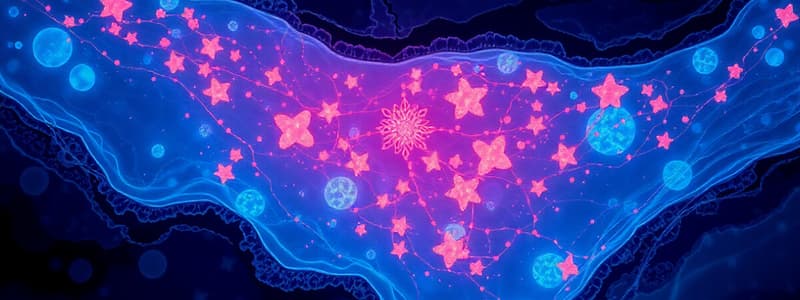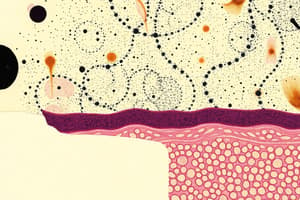Podcast
Questions and Answers
Which of the following is NOT a characteristic of epithelial tissue?
Which of the following is NOT a characteristic of epithelial tissue?
- Rich blood supply (correct)
- Lines internal closed cavities
- Covers exterior surfaces
- Avascular
Epithelial tissue does not form glands.
Epithelial tissue does not form glands.
False (B)
What are the three distinct surface domains of epithelial tissue?
What are the three distinct surface domains of epithelial tissue?
Apical, lateral, basal
Epithelial tissue rests on an underlying __________, which is a non-cellular layer rich in protein and polysaccharides.
Epithelial tissue rests on an underlying __________, which is a non-cellular layer rich in protein and polysaccharides.
Which characteristic refers to the arrangement of epithelial cells?
Which characteristic refers to the arrangement of epithelial cells?
Epithelial tissue is vascular, meaning it has its own blood supply.
Epithelial tissue is vascular, meaning it has its own blood supply.
What do the specific membrane proteins in epithelial tissues determine?
What do the specific membrane proteins in epithelial tissues determine?
The basal lamina is a non-cellular layer rich in __________ and polysaccharides.
The basal lamina is a non-cellular layer rich in __________ and polysaccharides.
Match the following characteristics with their definitions:
Match the following characteristics with their definitions:
What is a primary feature of epithelial tissue?
What is a primary feature of epithelial tissue?
Epithelial tissue can form secretory portions of glands.
Epithelial tissue can form secretory portions of glands.
What layer do epithelial cells rest on?
What layer do epithelial cells rest on?
Epithelial tissue lines __________ closed cavities in the body.
Epithelial tissue lines __________ closed cavities in the body.
Epithelial tissue is ______, meaning it lacks blood vessels.
Epithelial tissue is ______, meaning it lacks blood vessels.
Epithelial cells are arranged in ______ that cover surfaces and line cavities.
Epithelial cells are arranged in ______ that cover surfaces and line cavities.
Epithelial tissue possesses distinct surface ______: apical, lateral, and basal.
Epithelial tissue possesses distinct surface ______: apical, lateral, and basal.
The underlying layer that epithelial cells rest on is known as the ______ lamina.
The underlying layer that epithelial cells rest on is known as the ______ lamina.
The four basic types of tissues in the body include epithelial, connective, ______, and nervous tissue.
The four basic types of tissues in the body include epithelial, connective, ______, and nervous tissue.
Flashcards
Epithelial Tissue: Cell Arrangement
Epithelial Tissue: Cell Arrangement
Epithelial cells are arranged in tightly packed sheets, forming a continuous layer. They act as a barrier and protect underlying tissues.
Epithelial Tissue: Avascular
Epithelial Tissue: Avascular
Epithelial tissue lacks blood vessels and relies on diffusion from underlying connective tissue for nutrients and oxygen.
Epithelial Tissue: Covers Exterior Surfaces
Epithelial Tissue: Covers Exterior Surfaces
Epithelial tissue covers the outer surface of the body, such as skin, providing protection and regulating exchange with the environment.
Epithelial Tissue: Lines Internal Cavities
Epithelial Tissue: Lines Internal Cavities
Signup and view all the flashcards
Epithelial Tissue: Forms Glands
Epithelial Tissue: Forms Glands
Signup and view all the flashcards
Epithelial Tissue: Surface Domains
Epithelial Tissue: Surface Domains
Signup and view all the flashcards
Epithelial Tissue: Avascularity
Epithelial Tissue: Avascularity
Signup and view all the flashcards
Epithelial Tissue: Intercellular Junctions
Epithelial Tissue: Intercellular Junctions
Signup and view all the flashcards
What is the arrangement of epithelial cells?
What is the arrangement of epithelial cells?
Signup and view all the flashcards
How do epithelial tissues receive nutrients?
How do epithelial tissues receive nutrients?
Signup and view all the flashcards
What connects epithelial cells together?
What connects epithelial cells together?
Signup and view all the flashcards
What are the distinct regions of an epithelial cell?
What are the distinct regions of an epithelial cell?
Signup and view all the flashcards
Categorize epithelial tissues based on their shape and arrangement.
Categorize epithelial tissues based on their shape and arrangement.
Signup and view all the flashcards
Study Notes
Epithelial Tissue Characteristics
- Epithelial tissue is avascular, lacking blood vessels.
- It covers the exterior surfaces of the body.
- It lines internal closed cavities.
- It forms the secretory portion of glands and their ducts.
- It constitutes the receptors of certain sensory organs.
- Epithelial tissue exhibits diverse types.
- Cells are arranged in sheets.
- Cells possess intercellular junctions (junctional complexes).
- Cells display distinct surface domains: apical (free), lateral, and basal.
- Cell properties are determined by specific membrane proteins.
- Epithelial tissue rests on a basal lamina, a non-cellular, protein-polysaccharide-rich layer.
Types of Epithelial Tissue
- Further detail on types of epithelial tissue requires additional information (e.g., squamous, cuboidal, columnar, stratified, simple).
Basic Tissue Types
- Basic tissue types include epithelial, connective, muscle, and nervous tissues.
Questions
- Name the four basic tissue types.
Studying That Suits You
Use AI to generate personalized quizzes and flashcards to suit your learning preferences.
Description
This quiz covers the essential characteristics of epithelial tissue, including its avascular nature and its role in covering body surfaces and lining cavities. Additionally, it addresses the distinctive features of epithelial cells, such as their arrangement, surface domains, and intercellular junctions.




